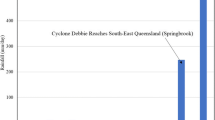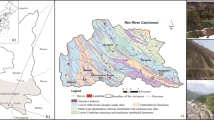Abstract
The potential for widespread landslides is generally increased when extraordinary wet periods occur during times of elevated subsurface hydrologic conditions. A series of storms in early 2018 in Pittsburgh, Pennsylvania, overlapped with a period of increased shallow soil moisture and rising bedrock groundwater levels resulting from seasonally diminished evapotranspiration and induced widespread landslides in the region. Most of the landslides were shallow slope failures in colluvium, landslide deposits, and/or fill. However, deep-seated landslide activity also occurred and corresponded with record cumulative precipitation from late February to April and bedrock groundwater levels rising to an annual high. Landslides blocked or damaged roads, adversely affected multiple houses, disrupted electrical service, crushed vehicles, and resulted in considerable economic losses. The initial landslides occurred during or immediately after a rare period of three successive days of heavy rain that began on February 14. Subsequent landslides between late February and April were induced by multiday storms with smaller rainfall totals. As shallow soil moisture at a monitoring site rose above a volumetric water content of 32%, the mean rainfall intensities necessary to induce slope failure in colluvium and other surficial deposits decreased. Deep-seated landslide movement occurred in the region mostly when the groundwater level in a bedrock observation well was shallower than 1.7 m. The availability of hydrologic and landslide movement monitoring data during this extraordinary series of storms highlighted the evolution of the landslide hazard with changing moisture conditions and yielded insights into potential hydrologic criteria for anticipating future widespread landslides in the region.














Similar content being viewed by others
References
Anderson LR, Keaton JR, Saarinen TF, Wells WG II (1984) The Utah landslides, debris flows, and floods of May and June 1983. National Academy Press, Washington, DC
Antronico L, Borrelli L, Coscarelli R, Pasqua AA, Petrucci O, Gullà G (2013) Slope movements induced by rainfalls damaging an urban area: the Catanzaro case study (Calabria, southern Italy). Landslides 10:801–814. https://doi.org/10.1007/s10346-013-0431-3
Ashland FX, Delano HL (2015) Continuous monitoring of meteorological conditions and movement of a deep-seated, persistently moving rockslide along Interstate Route 79 near Pittsburgh. Pennsylvania Geology 45(2):22–26
Bessette-Kirton EK, Cerovski-Darriau C, Schulz WH, Coe JA, Kean JW, Godt JW, Thomas MA, Hughes KS (2019) Landslides triggered by Hurricane Maria—assessment of an extreme event in Puerto Rico. GSA Today 29(6):4–10
Briggs RP, Pomeroy JS, Davies WE (1975) Landsliding in Allegheny County, Pennsylvania. US Geological Survey Circular 728
Czikowsky MJ, Fitzjarrald DR (2004) Evidence of seasonal changes in evapotranspiration in eastern U.S. hydrological records. J Hydrometeorol 5:974–988
Deere DU, Patton FD (1971) Slope stability in residual soils. Proc 4th Panamanian Conf Soil Mechanics and Foundation Engineering. ASCE. N Y 1:87–170
Glade T (2000) Modelling landslide-triggering rainfalls in different regions of New Zealand—the soil water status model. Z Geomorphol 122:63–84
Gray RE, Hamel JV, Adams WR Jr (2011) Landslides in the vicinity of Pittsburgh, Pennsylvania. In: Ruffolo RM, Ciampaglio CN (eds) From the Shield to the Sea—Geol Field Trips 2011 Joint Meeting GSA Northeastern and North-Central Sections. Geol Soc Am Field Guide 20:61–85
Hamel JV (1980) Geology and slope stability in western Pennsylvania. Bull Assoc Eng Geol 17:1–26
Handwerger AL, Fielding EJ, Huang M-H, Bennett GL, Liang C, Schulz WH (2019) Widespread initiation, reactivation, and acceleration of landslides in the northern California Coast Ranges due to extreme rainfall. J Geophys Res Earth Surf 124:1782–1797. https://doi.org/10.1029/2019JF005035
Kaliser BN, Slosson JE (1988) Geologic consequences of the 1983 wet year in Utah. Utah Geological and Mineral Survey Misc Publ Series 88-3
Montgomery DR, Dietrich WE, Torres R, Anderson SP, Heffner JT, Loague K (1997) Hydrologic response of a steep, unchanneled valley to natural and applied rainfall. Water Resour Res 33:91–109
Pomeroy JS (1977) Reconnaissance map showing landslides in Washington County, Pennsylvania. US Geological Survey Open-File Report 77-307, 5 scale 1:50,000
Pomeroy JS (1980) Storm-induced debris avalanching and related phenomena, Johnstown area, Pennsylvania, with references to other studies in the Appalachians. US Geological Survey Prof Paper 1191
Pomeroy JS (1982) Landslides in the Greater Pittsburgh region, Pennsylvania. US Geological Survey Prof Paper 1229
Pomeroy JS (1984) Storm-induced slope movements at East Brady, northwestern Pennsylvania. US Geological Survey Bull 1618
Radbruch-Hall DH, Colton RB, Davies WE, Skipp BA, Luchitta I, Varnes DJ (1976) Preliminary landslide overview map of the conterminous United States. US Geological Survey Misc Field Investig Map MF-771
Sidle RC, Ochiai, H (2006) Landslides—processes, prediction, and land use. American Geophysical Union, Washington, DC
Subitzky S (1975) Heavy storm precipitation and related mass movement, Allegheny County, Pennsylvania. US Geological Survey Misc Field Studies Map MF-641-D
Wieczorek GF, Eaton LS, Morgan BA, Wooten RM, Morrissey M (2009) An examination of selected historical rainfall-induced debris-flow events within the central and southern Appalachian Mountains of the eastern United States. US Geological Survey Open-File Report 2009–1155
Acknowledgements
The field investigations and research were supported by the USGS Natural Hazards Mission Area, Landslide Hazards Program. Constructive suggestions from an anonymous reviewer, Helen Delano (Pennsylvania Geological Survey), and Pete Chirico (USGS) substantially improved the presentation of the paper.
Author information
Authors and Affiliations
Corresponding author
Rights and permissions
About this article
Cite this article
Ashland, F.X. Critical shallow and deep hydrologic conditions associated with widespread landslides during a series of storms between February and April 2018 in Pittsburgh and vicinity, western Pennsylvania, USA. Landslides 18, 2159–2174 (2021). https://doi.org/10.1007/s10346-021-01665-x
Received:
Accepted:
Published:
Issue Date:
DOI: https://doi.org/10.1007/s10346-021-01665-x




